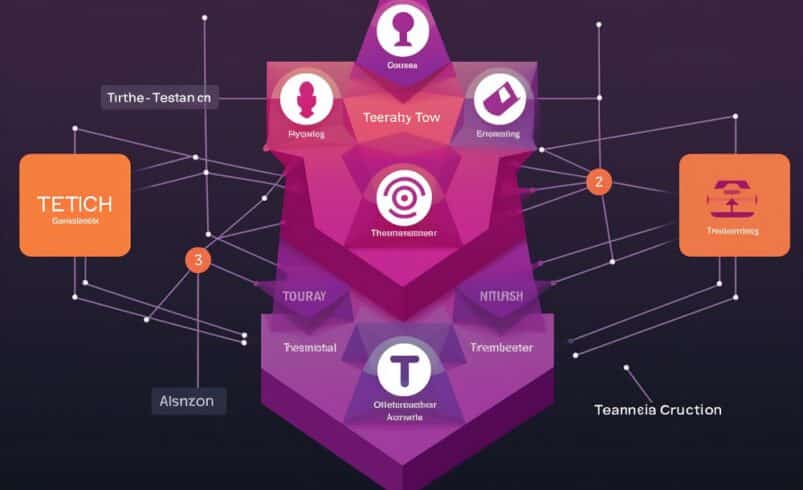Understanding Zero-Trust Architecture: The Blockchain Security Revolution

Table of Contents
In a digital world, trust plays a pivotal role. Celebrities thrive on building it, while scammers exploit it for deceit.
This guide sheds light on zero-trust architecture (ZTA), a crucial solution in blockchain security, changing how trust operates and why it matters.
What Is Zero-Trust Architecture (ZTA)?
Zero-trust architecture (ZTA) marks a seismic shift in cybersecurity, challenging the age-old concept of trust within networks. It involves verifying every interaction, no matter its origin.
Imagine it as an ongoing ID check at the door, ensuring only the right people gain access every time they seek entry. This revolutionary approach discards the traditional belief in inherent trust within a network.
Unlike the conventional model where trust is implied, ZTA mandates continuous verification for every action, user, or device, regardless of location or origin. ZTA ensures maximum security by adopting a skeptical stance toward every request.
Instead of a blanket trust approach, it treats each interaction as potentially risky until verified otherwise. By challenging the assumption of trust, ZTA acts as a guardian of network security.
It shifts the focus from safeguarding network perimeters to monitoring individual actions within the network. This meticulous scrutiny ensures that each transaction, interaction, or user movement undergoes thorough examination, minimizing the potential for security breaches or unauthorized access.
ZTA In Web3: The Dawn Of Trustless Internet
In Web3, zero-trust architecture (ZTA) heralds a new era where trust takes a backseat and verification steers the course. Web3’s foundation challenges traditional security paradigms and shifts towards a decentralized, trustless environment.
ZTA in Web3 mirrors this shift by integrating continuous cryptographic verification. Rather than placing blind faith in centralized authorities, Web3 embraces ZTA, ensuring every interaction within its network undergoes rigorous verification.
ZTA’s integration into Web3 is beyond fortifying security; it’s a radical shift towards empowering users with control over their digital footprints. By embedding trust within code rather than relying on central entities, Web3 pioneers a landscape of parallel transparency and security.
The trustless nature of Web3, underpinned by ZTA, establishes an ecosystem where transactions are transparent, yet identities remain safeguarded. ZTA in Web3 symbolizes a departure from traditional models, instilling a culture of verification and cryptographic integrity.
It transforms the internet into a decentralized, trustless domain where user sovereignty and security reign supreme.
How ZTA Works In Web3 Applications
In Web3 applications, zero-trust architecture (ZTA) operates like a vigilant gatekeeper, ensuring constant verification for every action. Each interaction undergoes a meticulous verification process, whether accessing wallets or authorizing transactions.
Users access their wallets using cryptographic keys, and transactions are initiated only after rigorous authentication with digital signatures. Once a transaction is created, it undergoes a thorough verification process through the blockchain network.
Blockchain nodes independently verify the transaction’s authenticity, ensuring it adheres to predefined rules before execution. Smart contracts enforce permission controls to prevent unauthorized access or actions.
Cryptographic authentication forms the backbone of this process, validating identities and ensuring transaction integrity at every step. This scrutiny and verification at each transactional stage exemplify the zero-trust ethos, safeguarding Web3 applications against threats.
Cryptographic Backbone
The cryptographic backbone forms the bedrock of security in Web3 applications, ensuring robust verification and data integrity at every level. Starting with SHA-256 encryption, this method solidifies data immutability, making any change in input yield vastly different outputs.
Consensus mechanisms like proof-of-work (PoW) or proof-of-stake (PoS) leverage cryptographic algorithms to achieve agreement within the network, ensuring every transaction and block undergoes multi-node verification. This layered cryptographic structure underscores a zero-trust environment, prioritizing verification over blind trust, thus fortifying the security and integrity of Web3 applications.
Conclusion
The transition from Web2’s perimeter-based security to Web3’s trustless model mirrors historical shifts. Web3’s evolution promises a more unrestricted, fairer internet where verification replaces blind trust.
Zero-trust architecture within Web3 isn’t just a security upgrade; it’s a gateway to a new era of digital freedom. It reshapes trust on the internet, ensuring a secure, user-centric environment for all.
Time Crypto Market offers content visibility for dozens of crypto enterprises, and you can be a part of our network! Reach out to us on our telegram chat for inquiries. The nature of cryptocurrencies is highly unpredictable; always perform your due diligence before any investment. Several articles on our site come from guest contributors or are commissioned pieces, not originating from Time Crypto Market's in-house writers. The perspectives shared in these articles might not necessarily align with those of Time Crypto Market. We do not assume responsibility for the veracity, caliber, promotions, offerings, or any other elements presented on our platform. Consult our comprehensive terms of service and disclaimer for more details.








